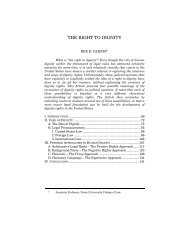A Right to Media? Lorie M. Graham - Columbia Law School
A Right to Media? Lorie M. Graham - Columbia Law School
A Right to Media? Lorie M. Graham - Columbia Law School
Create successful ePaper yourself
Turn your PDF publications into a flip-book with our unique Google optimized e-Paper software.
2010] A RIGHT TO MEDIA? 433<br />
Martinez Cobo was appointed Special Rapporteur for the study of the<br />
problem of discrimination against indigenous populations. 12 The<br />
Special Rapporteur’s 1984 Study on the Problem of Discrimination<br />
Against Indigenous Populations (the “Cobo Report”) evidenced the<br />
fact that many indigenous peoples were exposed <strong>to</strong> discrimination in<br />
a multitude of social, political, economic, and cultural contexts. 13<br />
Contained within the report was recognition of the impact of media<br />
on the lives of indigenous peoples. 14 For instance, the report<br />
documented how in many countries written and electronic<br />
information (such as books, magazines, periodicals, radio, and<br />
television) was inaccessible <strong>to</strong> many indigenous individuals,<br />
particularly those who could not read or write in the language of the<br />
dominant society. 15 Additionally, there was evidence of radio,<br />
television, and the press being used <strong>to</strong> exert cultural influences and<br />
pressures as illustrated by the following governmental excerpt:<br />
It is not just the demonstrable usefulness of the products of<br />
the national society that encourages people <strong>to</strong> consume<br />
them; the values of that society have been introduced<br />
through one of its media . . . in<strong>to</strong> the tribe as standards of<br />
what is good and evil, beautiful and ugly, attractive and<br />
paras. 3–5 (Terje Brantenberg et al. eds., Ctr. for Sami Studies, Pub. No. 2, 1995),<br />
available at http://www.sami.uit.no/girji/n02/en/102daes.html (tracing the his<strong>to</strong>ry<br />
of the discussion around the protection of indigenous peoples in the United<br />
Nations). In 1969, a report by the Special Rapporteur on the Study of Racial<br />
Discrimination in the Political, Economic, Social, and Cultural Spheres was<br />
presented <strong>to</strong> the Sub-Commission on Prevention of Discrimination and Protection<br />
of Minorities. Contained in this report was a chapter on discrimination against<br />
indigenous peoples. See Report from Special Rapporteur on the Study of Racial<br />
Discrimination in the Political, Economic, Social and Cultural Spheres, cited in<br />
id. para. 2. This marked the beginning of a discussion in both the Sub-<br />
Commission and in the Commission on Human <strong>Right</strong>s regarding the challenges<br />
faced by indigenous peoples. Recognizing the dearth of information on the<br />
subject, ECOSOC authorized a comprehensive study on the subject. See ECOSOC<br />
Res. 1589 (L), para. 7, 50th Sess., Supp. No. 1, U.N. Doc. E/5044 (May 21, 1971).<br />
12. Siegfried Wiessner, Professor, St. Thomas Univ. <strong>School</strong> of <strong>Law</strong>, U.N.<br />
Audiovisual Library of Int’l <strong>Law</strong>, Introduc<strong>to</strong>ry Note <strong>to</strong> United Nations<br />
Declaration on the <strong>Right</strong>s of Indigenous Peoples 3,<br />
http://untreaty.un.org/cod/avl/pdf/ha/ga_61-295/ga_61-295_e.pdf (last visited Feb.<br />
5, 2010).<br />
13. See generally Martinez Cobo June Report, supra note 8 (discussing the<br />
impact and interplay of culture and cultural, social and legal institutions with<br />
indigenous rights); Martinez Cobo Sept. Report, supra note 6 (defining<br />
“indigenous populations”).<br />
14. Martinez Cobo Sept. Report, supra note 6, para. 140.<br />
15. Martinez Cobo June Report, supra note 8, paras. 63, 67.















